Blog
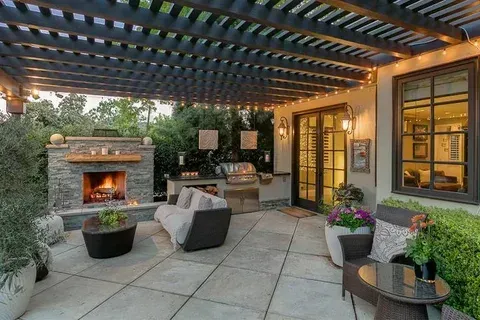
By Alex Hales
•
January 3, 2025
1. Definition and Location Patios: A patio is a paved or hard-surfaced area that is typically located at ground level in your backyard or garden. It is usually attached to the house but can also be a separate feature. Patios can be constructed with a wide variety of materials such as concrete, stone, tile, or brick. Features: Built at ground level, often with no railing. Can be attached or detached from the home. May feature outdoor furniture, gardens, and fire pits. Decks: A deck is an elevated outdoor platform that is typically made of wood, composite, or vinyl materials. It is often attached to the house and can vary in height, with many decks being raised several feet off the ground. Features: Elevated from the ground, often requiring railings. Usually made of wood, composite, or PVC materials. Commonly found at the back of the house, often providing access to upper floors. 2. Material Options Patios: Patios offer more material variety, as they are typically constructed using solid materials like: Concrete Brick Stone (flagstone, pavers, etc.) Tile Gravel The material choice for patios is broader, giving homeowners flexibility in terms of style, color, and texture. Decks: Decks are typically made from: Wood (pressure-treated, cedar, redwood) Composite (a blend of wood fibers and plastic) PVC (plastic-based material) While composite and PVC materials have gained popularity for their low-maintenance qualities, wood remains the classic choice for many homeowners. 3. Installation Process Patios: Patios are generally easier and quicker to install than decks, especially if you opt for simpler materials like gravel or pavers. However, complex stonework or custom designs may take longer. Patios typically require excavation and a solid base for proper drainage. Decks: Deck installation can be more complex and time-consuming, especially when it involves elevated structures and supports. Decks require a foundation (posts and footings) for stability, especially when elevated. The installation process can be more expensive due to labor and material costs. 4. Cost Differences Patios: Patios tend to be more affordable than decks, especially if you choose basic materials like concrete or gravel. However, the price can increase with premium materials like natural stone or intricate designs. Estimated Cost: Basic patios: $10–$20 per square foot. Premium materials or custom designs: $25–$50 per square foot. Decks: Decks are typically more expensive to build, especially with the use of high-quality wood, composite, or PVC materials. Elevated decks, particularly those requiring additional structural work, can significantly increase the overall cost. Estimated Cost: Basic wood decks: $15–$30 per square foot. Composite or PVC decks: $30–$60 per square foot. 5. Maintenance Needs Patios: Patios are low-maintenance compared to decks, especially if made from durable materials like stone or concrete. However, they still require occasional cleaning, resealing (for certain materials), and weed control between the pavers. Decks: Decks generally require more maintenance, especially if made from wood. Wood decks need to be sealed, stained, or painted regularly to protect them from the elements. Composite and PVC decks are lower-maintenance but still require occasional cleaning to remove dirt and debris. 6. Durability and Lifespan Patios: Patios made from materials like concrete, stone, or brick can last for many years with minimal maintenance. These materials are highly durable and resistant to weathering. Lifespan: Concrete patios can last 20–30 years or more. Stone or brick patios can last 50+ years with proper care. Decks: Decks, especially those made from wood, tend to have a shorter lifespan and can degrade over time due to exposure to the elements. Composite and PVC decks are more durable and can last longer than traditional wood decks. Lifespan: Wood decks typically last 10–15 years. Composite or PVC decks can last 25+ years with proper care. 7. Aesthetic Appeal and Style Patios: Patios can be highly customizable and fit a variety of styles. They work well with outdoor gardens and landscaping, often blending seamlessly into the natural surroundings. You can choose different paving patterns, materials, and decorative elements to create a unique look. Decks: Decks tend to have a more structured appearance due to their materials and elevated design. However, they can still be customized with railings, built-in seating, and decorative touches. Decks provide a more modern or rustic appeal, depending on the materials chosen. 8. Usage and Functionality Patios: Patios are perfect for dining, lounging, gardening, or hosting events. Since they are on the ground level, they provide more space for furniture and other features like outdoor kitchens, gardens, and fire pits. Decks: Decks provide great spaces for outdoor living, such as relaxing, entertaining, or dining. Elevated decks are ideal for homes with a view, as they allow you to enjoy the scenery from a higher vantage point. 9. Resale Value Patios: Patios can increase the value of your home, especially if made from high-quality materials like natural stone. They are considered an attractive feature by many buyers, especially in warmer climates where outdoor living is popular. Decks: Decks also offer significant resale value, particularly in areas with a lot of outdoor activity. They are often seen as an extension of the living space and can increase the appeal of a property. Conclusion Both patios and decks are excellent additions to your outdoor space, each offering unique advantages. A patio provides a low-maintenance, cost-effective outdoor area that seamlessly blends with the landscape. On the other hand, a deck offers versatility, elevated views, and a more modern aesthetic. The decision ultimately comes down to your budget, the style of your home, your maintenance preferences, and how you plan to use the space. Whether you opt for a patio or a deck, both can enhance your outdoor living experience and increase the value of your home. FAQs 1. Is a deck more expensive than other outdoor options? Yes, decks are typically more expensive due to material costs and the complexity of installation, especially if elevated. 2. How long does a deck last? Wooden decks last about 10-15 years, while composite or PVC decks can last 25+ years with proper maintenance. 3. What maintenance does a deck need? Wooden decks require regular sealing, staining, and cleaning, while composite and PVC decks need less maintenance but should be cleaned occasionally. 4. Can I install a deck myself? DIY installation is possible for small decks, but larger or elevated structures are best left to professionals for safety and structural integrity. 5. What is the best material for a deck? Wood, composite, and PVC are popular options, with composite and PVC offering lower maintenance and better durability, while wood offers a traditional, natural look.
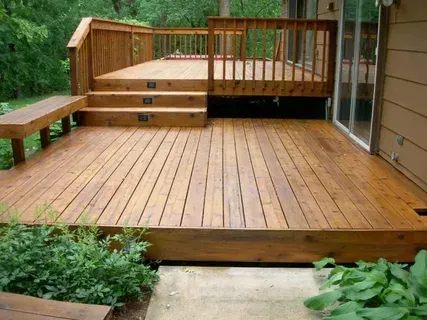
By Alex Hales
•
January 1, 2025
1. Wooden Decks Classic and Timeless Look Wooden decks are the traditional choice for outdoor spaces and remain a popular option due to their natural beauty and timeless appeal. Wood provides a warm and inviting feel, making it ideal for almost any style of home. Types of Wood Used: Pressure-treated wood: Affordable and resistant to decay, this is one of the most commonly used materials for outdoor decks. Cedar and redwood: These naturally resistant woods are durable and have a rich color, offering an upscale appearance. Pros: Natural aesthetic that complements most home styles. Customizable design options. Can be stained or painted to match your décor. Cons: Requires regular maintenance such as sealing, staining, and cleaning. Can warp or crack over time due to weather exposure. 2. Composite Decks Low-Maintenance and Durable Composite decks are made from a blend of wood fibers and plastic, offering the best of both worlds: the look of wood with the durability of synthetic materials. These decks are designed to resist fading, stains, and scratches, making them a popular choice for homeowners who prefer low-maintenance options. Pros: Low maintenance—no need to seal, stain, or paint. Resistant to rot, mold, and insects. Available in a wide range of colors and textures to mimic natural wood. Cons: Higher upfront cost compared to wood. Can get hot underfoot in direct sunlight. May show wear or fading over time, especially in high-traffic areas. 3. PVC Decks Fully Synthetic for Maximum Durability PVC (polyvinyl chloride) decks are completely synthetic, made from plastic, and are designed to withstand harsh weather conditions. Unlike composite decks, PVC does not contain any wood fibers, making it even more resistant to moisture, mold, and mildew. Pros: Highly durable and resistant to weathering, rot, and pests. Extremely low maintenance—no need for staining or sealing. Comes in a variety of colors and finishes. Cons: Can be slippery when wet. May fade in color over time, especially in areas with lots of sun exposure. Higher cost compared to wood or composite decks. 4. Aluminum Decks Modern, Durable, and Weather-Resistant Aluminum decks are known for their strength and longevity. These decks are made from extruded aluminum, which is lightweight yet strong and resistant to rust, corrosion, and fading. Aluminum decks are particularly ideal for coastal areas where saltwater can damage traditional materials. Pros: Extremely durable and rust-resistant. Low maintenance and fire-resistant. Available in different colors and finishes. Cons: Higher initial cost compared to wood or composite. Can be noisy during rain as water may make a louder sound on the surface. Limited texture options compared to wood or composite. 5. Pressure-Treated Wood Decks Affordable and Functional Pressure-treated wood is one of the most budget-friendly materials for deck construction. This wood has been chemically treated to resist decay, mold, and insect damage, making it an excellent option for areas that experience high moisture or humidity. Pros: Cost-effective and widely available. Durable and resistant to rot and pests. Can be stained or painted to match your preferences. Cons: Requires periodic maintenance to prevent cracking and fading. May not last as long as higher-end materials like composite or PVC. 6. Ipe Decks Luxury Decking with High Durability Ipe is a high-end hardwood often referred to as “Brazilian walnut.” It is known for its durability, rich color, and resistance to the elements. Ipe decks are incredibly strong and resistant to scratches, fading, and wear, making them an ideal choice for homeowners who want a long-lasting, luxurious outdoor space. Pros: Extremely durable and resistant to weather, insects, and rot. Rich, attractive appearance with a deep brown color. Low maintenance compared to other natural wood options. Cons: High upfront cost due to the premium nature of the material. Can be difficult to install due to its density. Requires periodic oiling to maintain its appearance. 7. Rooftop Decks Maximizing Space in Urban Areas Rooftop decks are an excellent choice for urban homes or properties with limited outdoor space. These decks are installed on the roof of a building, offering an elevated outdoor living area with a unique view of the surrounding area. Pros: Maximizes available space, especially for homes with limited yard area. Provides stunning views and a private retreat. Can be customized with furniture, gardens, and other outdoor features. Cons: May require additional structural support, making installation more expensive. Prone to weather-related issues such as wind and rain. Can be more challenging to access and maintain. 8. Multi-Level Decks Perfect for Sloped Properties If you have a sloped or uneven backyard, a multi-level deck can be a great solution. This design involves creating multiple deck levels that are connected by stairs, allowing you to make the most of the landscape. Pros: Ideal for sloped or uneven yards. Provides additional space for outdoor living. Can include multiple zones for dining, relaxing, or gardening. Cons: More complex and expensive to install. Requires more maintenance and upkeep due to multiple levels and stairs. 9. Wraparound Decks Spacious and Inviting Wraparound decks extend around the perimeter of a home, often providing access to multiple entry points or offering a panoramic view of the surroundings. This type of deck is perfect for homeowners who want a spacious and versatile outdoor area. Pros: Provides ample space for entertaining and relaxing. Increases the flow between indoor and outdoor living areas. Can add significant curb appeal and value to your home. Cons: Requires a larger yard and more materials, increasing the cost. Maintenance can be time-consuming due to the large surface area. 10. Decks with Built-In Features Customizable Deck Designs Many homeowners opt for decks that include built-in features such as seating, planters, fire pits, or even outdoor kitchens. These added features can enhance the functionality of your deck, creating a more enjoyable and luxurious outdoor space. Common Features: Built-in benches and seating areas. Fire pits or outdoor fireplaces for warmth and ambiance. Outdoor kitchens with grills, sinks, and refrigerators. Planter boxes or garden beds to add greenery. 11. Conclusion When choosing a deck for your outdoor space, it’s important to consider the material, design, and features that best suit your lifestyle and home environment. Whether you prefer the natural beauty of wood, the low-maintenance appeal of composite or PVC, or the durability of aluminum, there is a deck type that will complement your needs. By carefully evaluating the pros and cons of each deck type, you can create a beautiful and functional outdoor living area that enhances your home’s curb appeal and your quality of life. FAQs 1. What is the most affordable deck material? Pressure-treated wood is generally the most affordable option for building a deck, offering durability and functionality at a lower cost. 2. Which type of deck requires the least maintenance? Composite and PVC decks require the least maintenance, as they don’t need sealing, staining, or painting like wood decks do. 3. How long does a wooden deck last? A well-maintained wooden deck can last 10-15 years, but this can vary based on the type of wood and environmental factors. 4. Are aluminum decks a good option? Yes, aluminum decks are durable, rust-resistant, and require very little maintenance, but they are generally more expensive than wood or composite options. 5. Can I install a deck myself? While smaller decks can be DIY projects, it’s recommended to hire professionals for larger or more complex deck installations, especially when dealing with structural integrity and building codes.
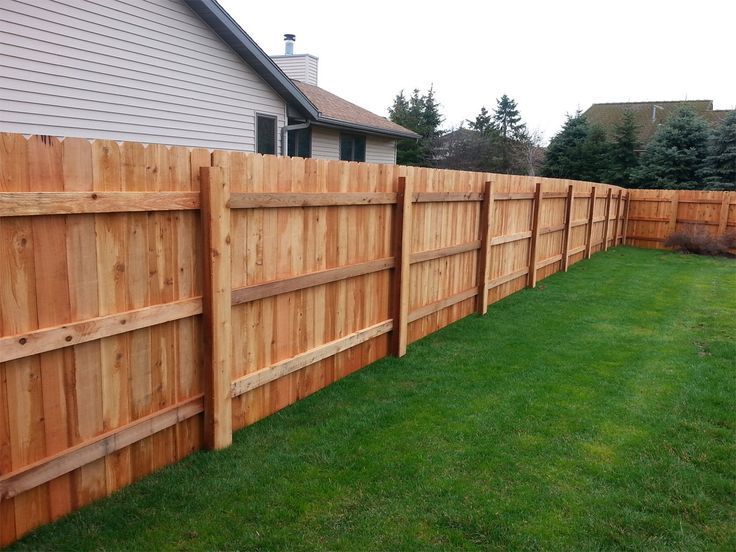
By Alex Hales
•
December 17, 2024
Benefits of Fence Installation Investing in Fence Installation offers a range of advantages that extend beyond just demarcating property boundaries. 1. Enhanced Security Fences provide a vital layer of security by keeping intruders out and ensuring children and pets stay safely within your property. 2. Improved Privacy A sturdy, well-designed fence blocks unwanted views, allowing you to enjoy your outdoor space without intrusion. 3. Aesthetic Appeal Fences come in a variety of designs and materials that can elevate the overall appearance of your home or business, enhancing curb appeal and adding value. 4. Noise Reduction For properties near busy streets, fences can act as sound barriers, reducing the noise that reaches your home. 5. Increased Property Value Well-maintained fences add functional and aesthetic value to a property, making it more appealing to potential buyers. 6. Boundary Definition Clear boundary lines provided by fences reduce disputes with neighbors and ensure the efficient use of land. Types of Fence Installation Services When it comes to Fence Installation, there are numerous styles and materials available, each tailored to specific needs and preferences. 1. Wood Fencing Known for its classic and natural look, wood fencing is versatile, affordable, and can be customized with stains or paints. 2. Vinyl Fencing Vinyl is a durable, low-maintenance option resistant to weather, pests, and fading, making it ideal for long-term use. 3. Chain Link Fencing Perfect for security purposes, chain link fences are durable, cost-effective, and suitable for residential, commercial, and industrial properties. 4. Metal Fencing Options like aluminum, wrought iron, and steel offer elegance and strength, often chosen for decorative purposes while ensuring security. 5. Composite Fencing Made from a mix of wood fibers and plastic, composite fences offer the beauty of wood with the durability and low maintenance of plastic. 6. Picket Fencing This traditional style, often made of wood or vinyl, adds charm and enhances the visual appeal of a home. 7. Privacy Fencing Designed for maximum seclusion, these fences are often tall and made of materials like wood, vinyl, or composite. How Deck Installation Service Works A well-constructed deck transforms outdoor spaces into functional and inviting areas for gatherings, relaxation, and entertainment. Here’s how a professional Decking Installation service typically works: 1. Initial Consultation The process begins with a consultation to understand your goals, preferences, and budget. Professionals evaluate your space and discuss design options, materials, and timelines. 2. Design Planning Based on your input, a custom deck design is created. This includes selecting materials such as wood, composite, or PVC and finalizing the layout, dimensions, and additional features like railings or built-in seating. 3. Site Preparation The installation team prepares the site by clearing debris, leveling the ground, and ensuring the foundation meets local building codes. 4. Material Procurement Once the design is finalized, materials are sourced, ensuring quality and durability to meet your requirements. 5. Deck Construction Construction begins with laying the foundation and framing, followed by installing the deck boards and additional features. Precision and attention to detail ensure a sturdy and visually appealing structure. 6. Finishing Touches After the main structure is complete, professionals add finishing touches such as staining, painting, or sealing to protect the deck from weather and enhance its appearance. 7. Final Inspection Once the deck is finished, a thorough inspection is conducted to ensure it meets safety standards and your expectations. Final Thoughts Whether it’s Fence Installation for security and privacy or Decking Installation to create an outdoor retreat, investing in professional services ensures quality and long-lasting results. The right fence or deck can enhance your property’s functionality, aesthetics, and value, making it a worthwhile addition to any home or business. By working with experienced professionals, you’ll enjoy peace of mind knowing the job is done right. For reliable and professional fence and decking services, P&S Fencing is your trusted partner. With a commitment to excellence and customer satisfaction, their team delivers customized solutions that cater to your specific needs. Whether you’re looking to secure your property or elevate your outdoor living space, P&S Fencing provides the expertise and quality you deserve.
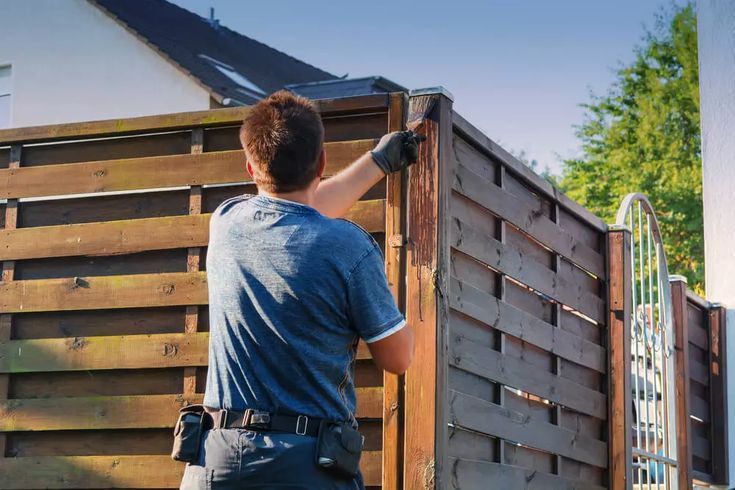
By Alex Hales
•
November 28, 2024
Why Regular Fence Repair and Maintenance is Important When it comes to caring for your fence, many homeowners only think about it when something goes wrong. However, regular maintenance is key to keeping your fence strong and lasting longer. By doing simple checks and taking care of minor repairs as they happen, you can avoid expensive fence repair later on. Fences are exposed to weather every day. They face everything from strong sun and heavy rain to freezing cold and strong winds. This weather takes its toll over time. Regular maintenance, such as cleaning, sealing, and fixing weak spots, can stop these weather conditions from causing big damage. By staying on top of small repairs, you can avoid costly fence repair in the future. Preventing Rot and Decay One of the most common problems for fences, especially wooden ones, is rot. Wood can easily soak up water, causing it to swell, bend, and eventually rot. If this issue is not taken care of right away, it can lead to major damage that may require expensive fence repair. To prevent rot, it’s important to regularly check the posts, rails, and panels for signs of moisture damage. Applying a good-quality wood sealant or stain can also protect the wood from water damage. By resealing your fence every couple of years, you can keep water from causing rot. This simple step can help you avoid needing expensive fence repair or replacement later. Preventing Fence Post Damage The posts of your fence are its foundation. If these posts are damaged, the entire fence could fall apart. Posts are especially vulnerable to shifting and rotting, especially if they were not installed correctly or have not been properly maintained. If the posts start to weaken, your fence can start to lean, sag, or even fall over during a storm. To avoid expensive fence repair, check your fence posts regularly for stability. Look for signs of leaning, cracks, or decay. If you spot any issues, it’s best to fix them right away. Reinforcing weak posts or replacing damaged ones can stop small problems from turning into bigger issues that will cost you more to repair. Checking the foundation of the posts is also important—make sure they aren’t sitting in standing water, which can cause them to rot faster. Avoiding Damage from Landscaping Many homeowners don’t realize that plants and landscaping can damage their fence. Over time, tree roots can grow into fence posts, weakening them. Vines, branches, and bushes can also put pressure on the fence, causing it to bend or break. To prevent this damage, make sure your plants are not too close to the fence. Trim trees regularly to stop branches from hanging over the fence and causing damage. Keep vines and climbing plants away from the fence as well, as they can trap moisture against the surface, leading to rot and decay. Protecting Against Weather Damage Weather is one of the biggest causes of fence damage. Strong winds, heavy rain, snow, and extreme temperatures can all cause fences to weaken. In places where freezing and thawing happen often, the constant changes in temperature can cause the materials to crack. In areas with a lot of rain, moisture can rust metal fences or cause mold and mildew to grow on wooden fences. To protect your fence from weather damage, it’s a good idea to check it before and after each season. After winter, look for signs of cracks or damage from ice and snow. Before storm season, make sure your fence is secure by checking for loose panels or posts. Cleaning and treating your fence with weather-resistant products, such as rust-proof paint for metal fences or waterproof sealant for wooden fences, can also help protect it. Taking care of your fence during tough weather can lower the chance of needing expensive fence repair. Keeping Fence Hardware in Good Shape Your fence isn’t just made of posts and panels—it also has hardware, such as hinges, latches, and locks. Over time, these parts can rust or become loose, which can weaken the entire fence. To avoid the cost of replacing hardware or doing large repairs, check these parts regularly. Make sure the hinges are tightly attached and that the latches work properly. If you see any rust, remove it and apply a lubricant to stop it from spreading. Keeping all the hardware clean and working properly will help your fence stay strong and prevent costly repairs in the future. Fixing Small Problems Before They Get Bigger One of the best ways to avoid costly fence repair is by noticing small problems early. A tiny crack, a loose nail, or a broken panel may seem like nothing at first, but these small issues can turn into big problems if they are ignored. A small crack in a wooden panel can let moisture in, which can cause rot. A loose nail can cause a section of the fence to sag, putting more pressure on the other parts of the fence. By regularly checking your fence and fixing small problems right away, you can save yourself from bigger and more expensive repairs later. Fixing things like a loose screw or a damaged panel is much cheaper than dealing with a whole section of the fence that has fallen apart. Hiring Professional Fence Repair Services Even with regular maintenance, there may be times when your fence needs more than just simple repairs. If your fence needs significant work, it’s best to call in a professional fence repair company, like P and S Fencing. Hiring an expert ensures that repairs are done properly, and that your fence stays in great condition for many years. Professionals can also do detailed inspections that might catch problems you might have missed. Whether it’s reinforcing weak spots, replacing broken posts, or fixing drainage issues, experts have the skills and equipment to keep your fence in good shape and prevent further damage. Conclusion: The Value of Regular Fence Maintenance Regular maintenance is one of the most important ways to avoid costly fence repair. By checking your fence for damage, fixing small issues, protecting it from moisture and weather damage, and maintaining hardware and landscaping, you can make your fence last longer and avoid expensive repairs. Taking care of your fence can save you money and help keep your property safe and looking great. At P and S Fencing , we specialize in fence repair and maintenance, making sure your fence stays in top condition. Contact us today to schedule an inspection or maintenance service and keep your fence strong and lasting for years to come.
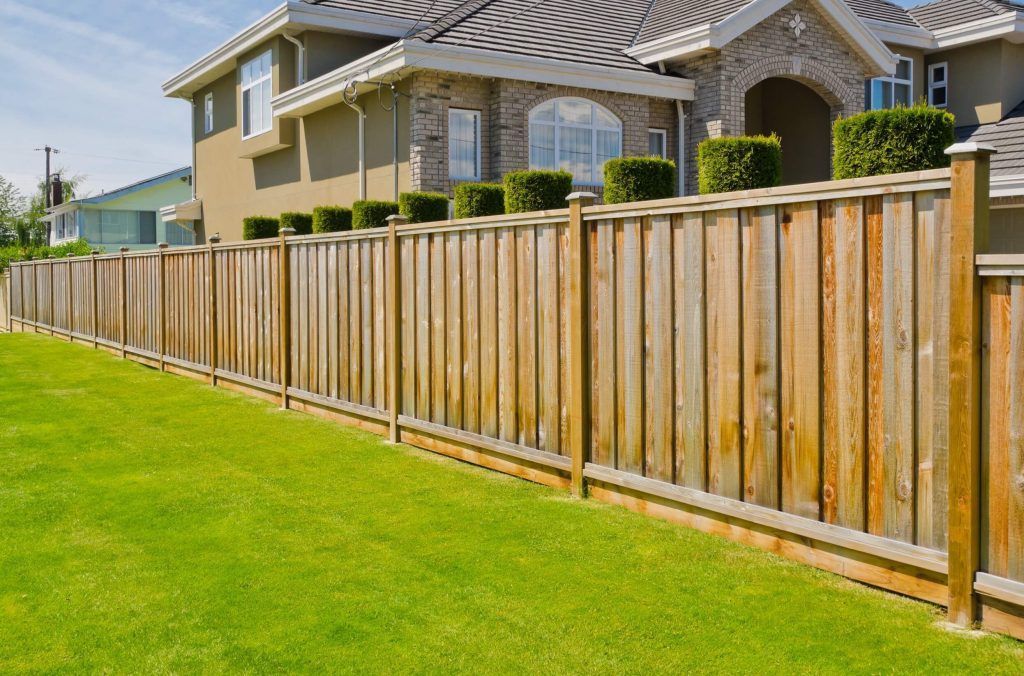
By Alex Hales
•
September 3, 2024
How to Prepare Your Property for Fencing Installation? Your property’s security, privacy, and visual appeal can all be greatly improved by installing a fence. But for a seamless installation and a long-lasting outcome, enough planning is essential. By following the correct procedures prior to installation, you can avoid wasting time, energy, and sometimes even headaches while building a fence for the first time or replacing an old one. The fundamental setup requirements for a successful fencing installation will be guided through by this tutorial. Define Your Purpose Establishing the goal of your fence is crucial before you start any physical preparations. Do you want to designate property boundaries, boost security, or enhance privacy? Selecting the ideal fence style, material, and design will be made easier if you know what your objectives are. For seclusion, a fence would need to have solid panels; for decoration, a fence might need to have more detailed patterns. Check Local Regulations and Obtain Permits Regarding the fencing installation, the majority of towns have zoning laws and certain rules. Your fence’s height, design, and location may be determined by these guidelines. To comprehend these rules and acquire any required permits, it is imperative that you get in touch with your local government or homeowners organization. There may be fines or your fence being forcibly taken down if you break municipal codes. Locate Property Lines Resolving conflicts with neighbors and possible legal problems requires accurate property boundary delineation. For specific information about your boundaries, go to your deed or property survey. You can think about hiring a qualified surveyor to mark the precise lines if you don’t have a recent survey. By doing this, you can make sure your fence is constructed inside your property lines and complies with existing laws. Consider Utility Lines Finding any underground utility lines, such as those for gas, water, and electricity, is essential before beginning any digging. A utility line struck during fencing installation might result in major disruptions and provide safety hazards. Make use of a utility locating service or get in touch with your local utility company to label these lines. This service is free in many places and helps guard against unintentional damage. Plan Your Fence Design The procedure of installing your fence will go more smoothly if your design is well thought out. Choose the fence’s style, composition, and color. To see the final design, make a thorough sketch or use fence planning software. Any hills or uneven ground should be considered, as these will affect the fence’s construction. Mark the Fence Line Mark your property’s intended fence line once you’ve decided on a design. To mark the location of the fence, use stakes, thread, or spray paint. This will assist you in seeing the arrangement and adjusting as needed before the fencing installation process starts. It also helps contractors grasp your goals and specifications. Clear the Area Prepare the fencing installation location by removing any obstructions. Clear the area around any current fences, tree stumps, rocks, and other objects that could get in the way of installing the fence. Any overhanging plants or branches that can hinder building should be pruned. Maintaining a clean environment helps to protect your new fence and guarantees a more seamless installation. Prepare the Ground An important consideration is the state of the ground on which the fence will be erected. Make sure the soil is sturdy and level. You may need to grade the area in order to enable appropriate fencing installation on slopes or uneven terrain. This could entail shifting soil around to make the surface more level. An effective ground preparation contributes to the fence’s durability and stability. Gather Necessary Tools and Materials Make sure you have every instrument and item required for the fencing installation. Posts, panels, concrete, post anchors, screws, and any other hardware unique to your style of fence are included in this. Even though a contractor you hire will provide their own tools, it’s still helpful to know what is needed. Having everything ready before you begin will help to ensure a faster and more efficient procedure. Install Fence Posts Installing fence posts is an essential step since they give your fence its structural support. Make sure the post holes are deep enough to provide stability by using a post hole digger to remove the holes. For posts to be securely fastened in place, concrete should usually be used. Make sure the posts are positioned and level with respect to the design of your fence. For a fence to be strong and durable, posts must be installed correctly. Attach Fence Panels Attach the fence panels to the posts after they have been firmly placed. This could entail nailing or screwing the panels into place, depending on how your fence is designed. Make sure the panels are level and properly positioned. Take your time to verify dimensions and alignments in order to prevent problems with the final product. Check for Quality and Stability Check the overall stability and quality of the structure after the fence panels are mounted. Make sure the panels are fastened firmly and that all of the posts are in place. Check for any holes, crooked edges, or loose fasteners. Before adding the finishing touches, take care of any problems to guarantee a high-quality finished product. Apply Finishing Touches After fencing installation, depending on the material, you may need to apply finishing touches such as paint, stain, or sealant. In addition to shielding the fence from wear and weathering, these treatments can improve the fence’s look. To get the greatest effects, apply the product according to the manufacturer’s directions. Conclusion Setting up a fence on your property requires a number of critical processes, from goal-setting to upkeep of the completed structure. A seamless installation procedure and a fence that fulfills your requirements and expectations can be guaranteed by adhering to these recommendations. You will have a strong, beautiful fence that adds to the utility and value of your home if you take the time to properly prepare.
© 2025
P&S Fencing and Decking

